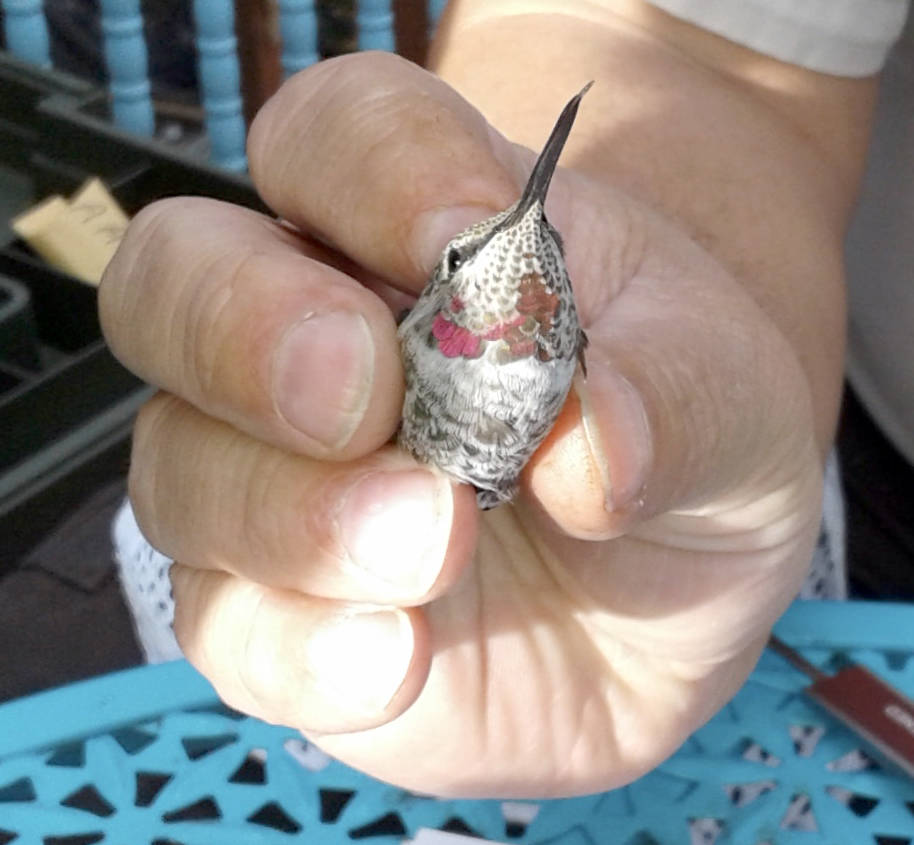Oct. 17, 2018, will be one for the record books. The day began like many others, dealing with an injured bald eagle that needed transport to Bird Treatment and Learning Center in Anchorage for evaluation and, hopefully, rehabilitation. After wrestling 10 pounds of muscle-bound male eagle into a pet carrier for transport, I turned my truck south and headed for Homer.
In August, I wrote about my trip to Idaho to get certified for banding hummingbirds. So I was glad to apply my new skill set as there was a report of two Anna’s Hummingbirds at a private residence in Homer.
It didn’t take long after arriving to find the hummingbird. He intermittently sang from his alder perch when not scolding me for messing with “his” feeder. I let him get comfortable with the setup of his feeder hanging inside my trap for about 20 minutes while I prepped the rest of my banding equipment.
When I sprung the trap on him, he only seemed slightly concerned, even resuming his feeding inside the trap. He was far from happy when I actually got ahold of him and he jacked his little wings out and up as hard as he could. When I folded them in place next to his body to keep him safe, it almost felt as if I were going to break something.
After placing the leg band on his right leg and taking several measurements, I concluded it was an immature male Anna’s Hummingbird born sometime this summer. But where did it come from? Anna’s supposedly do not breed here yet, but for the past five years or so they have shown up regularly in Homer and Seward in late fall.
With an additional permit, I was allowed to collect one tail feather that will grow back in two or three weeks. That tail feather will be part of a study being conducted by Jessica Pollock from Boise State University. She is looking at the proportion of several stable isotopes to determine where the bird was when that feather was grown.
Unfortunately, this male Anna’s had just replaced its tail while here in Homer so the isotope signature will be from Homer rather than helping to unravel the mystery of his birthplace.
All is not lost, however, as this will give us the isotopic profile for Homer. If future sampled birds with retained juvenile feathers have that same signature, we will know that Anna’s breeding range has now reached Southcentral Alaska.
I initially believed this was the all-time northernmost banding record for the species, with Cordova being the other banding location in Alaska. I was quickly corrected that this record was the farthest west, but Cordova is actually farther north than Homer, so Cordova still has that claim.
A quick glance at the map and you’ll see that the city of Kenai is less than a mile north of Cordova, so Cordova has Homer beat by a long shot.
It was also quite a diverse day for me birdwise. I handled both the bald eagle, which is arguably the largest bird on the peninsula at roughly 4,500 grams, and Anna’s Hummingbird, which is 1,000 times smaller at 4.7 grams.
I am still struck by the power in that little wing as he held it up not wanting me to close it next to his body. How do they have so much strength holding their wings out? I’ve banded thousands of birds, but I have never felt that kind of power on the upstroke, only on the downstroke.
A little digging and it totally makes sense. We all know about the breast muscles in birds, also called the pectoralis major, which is what we like to eat in chickens, turkeys, grouse and waterfowl. The pectorals are big and powerful, pulling the wings down and providing lift.
But directly underneath that muscle, separated by a thin membrane, is the supracoracoideus muscle. It is the shiny little muscle that peels out when you breast out a chicken and is sold as chicken tenders. It has a large tendon at the forward end that forms a unique rope-and-pulley system.
From the breast side of the bird, the tendon wraps over the shoulder blades and out the top of the wing. When contracted, this muscle pulls the wing on the upstroke and allows birds to hold the wing in place while soaring.
In most birds, the supracoracoideus is about one-fifth the size of the pectoralis muscle. In hummingbirds, however, their supracoracoideus is half the size of the pectoralis because they are tasked with much more than just upstroke recovery.
Hummingbirds can back up, hover and perform aerobatic maneuvers that other birds cannot. So the pound-for-pound strength of this 4-gram bird holding its wing up was not a figment of my imagination, but rather the result of a sophisticated mechanism giving them superior maneuverability. Who knew?
Todd Eskelin is a Wildlife Biologist at Kenai National Wildlife Refuge. Call him at (907) 260-2817 if you have interesting bird sightings. Find more Refuge Notebook articles (1999-present) at https://www.fws.gov/Refuge/Kenai/community/Refuge_notebook.html.

